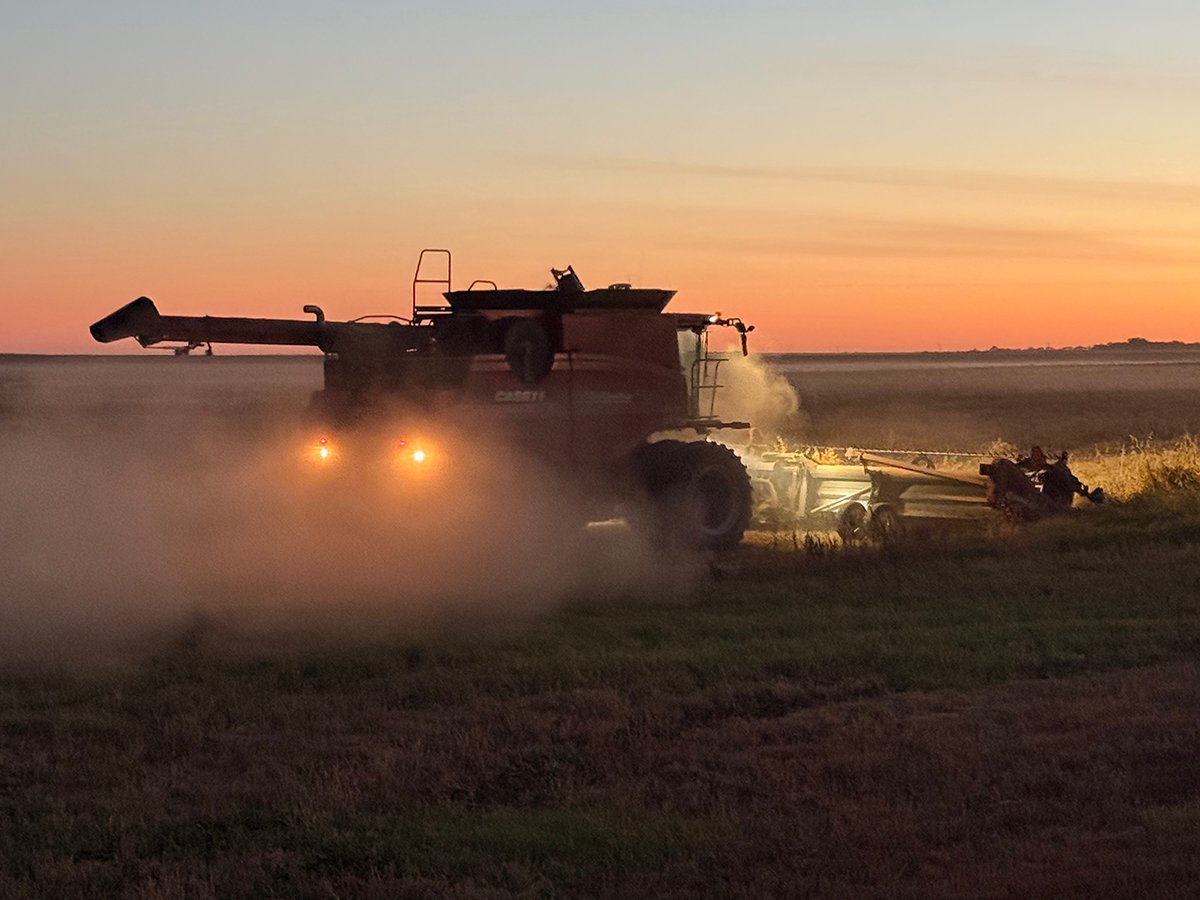Quilting book, Mexican food
At the Canadian Home Economics Association Convention in Victoria, I attended a session by author and quilter Gail Hunt. While trying to get back into the groove of doing the things that need to be done on the farm, my mind keeps going back to her presentation. In order to relive the presentation, I’m so happy I brought home her first and newly printed book, Quiltworks Across Canada.
Gail’s own story of having a burning desire to give recognition to quilters from all parts of Canada, “who work quietly and diligently, making artistic statements for private or public benefit,” tells us why she wanted to publish the book.
Read Also

Downturn in grain farm economics threatens to be long term
We might look back at this fall as the turning point in grain farm economics — the point where making money became really difficult.
Each quilter she interviewed was asked to present a workshop of a specific quilting technique. Gail says “this book is designed to be beautiful to look at, as well as a practical how-to guide for a smorgasbord of contemporary quilting techniques. It is not designed to teach basic quilt-making skills, rather it is about extras, some fun and exploration.”
Blueprinting photos onto fabric; confetti impressions; “watercolor” painting with fibre; shibori dyeing; using real flowers from the garden; and other techniques have step-by-step instructions with illustrations and pictures.
Quiltworks Across Canada by Gail P. Hunt, is published by Pacific Quiltworks Ltd., 4740 Mountain Highway, North Vancouver, B.C., V7K 2Z9.
Making tortillas
A reader has requested recipes for making tortillas (the soft type) and burritos.
Tortillas are the national bread of Mexico. They are flat, like thin unleavened pancakes, and made from masa (corn) or wheat dough. The dough is cooked on an ungreased griddle and can be eaten when fresh and pliable or when dry and crisp.
Tortillas can be served alone as bread, piled high with any filling or wrapped around other foods. Fillings are used such as refried beans, shredded vegetables, meats, chunks of poultry or fish, wedges of cheese or scrambled eggs.
When visiting Mexican restaurants, I often need to ask what a particular dish will be like. For those like me, I have included, with the recipes, a description of Mexican dishes that use tortillas as their basis.
Burritos: Large tortillas wrapped around fillings, that can be eaten in your hand or cooked in a sauce and eaten from a plate.
Tacos: Tortillas folded in half and fried crisp. Fillings are spooned into the tacos, then topped with fresh garnishes such as tomatoes, lettuce, onion and shredded cheese.
Enchiladas: Tortillas wrapped around fillings, baked in a sauce and served with salsa and garnishes.
Tostaditos: Crisp fried tortillas with meat, beans and garnishes.
Totopos: Small crisp baked pieces of tortillas, similar to corn chips, used as snacks or appetizers and served with salsa and dips.
Nachos: Small crisp tortillas topped with foods such as refried beans, cheese, tomatoes and peppers and then heated in the oven until the cheese melts.
Quesadillas: Fresh, uncooked tortillas, folded in half over a filling, the edges pressed together and deep-fried.
Flour tortillas
2 cups all- 500 mL
purpose flour
1 teaspoon salt 5 mL
1 teaspoon baking 5 mL powder
1 tablespoon 15 mL
shortening
3Ú4 cup warm 175 mL
water
Combine flour, salt and baking powder in a large bowl. Cut in shortening until the mixture resembles coarse meal. Add water and mix until the dough can be shaped into a ball. If too sticky, add one to two tablespoons (15-30 mL) flour. If too dry, add a little more water. Cover the bowl and let the dough rest for 15 minutes. Divide dough into 12 pieces and shape each into a ball. Place one ball at a time on a lightly floured board, flatten it out and roll it into a seven-inch (18 centimetre) circle.
Continue making tortillas, stacking them on a floured plate, making sure they do not stick together.
Heat an ungreased griddle or heavy frying pan until very hot. Reduce heat slightly. Carefully put a tortilla on the griddle. Cook about one or two minutes until bubbles appear. Turn and cook about 30 seconds more. If cooked too long, tortillas will be dry and brittle.
Stack in a cloth-lined basket.
Source: I’d Like to Know by Emmie Oddie, Western Producer, May 25, 1995.
Chicken burritos
This is just one of many fillings that can be used.
3Ú4 pound 375 g
boneless, skinless chicken breast cut in
one-inch (2.5 cm) strips
1 teaspoon chili 5 mL
powder
4 10-inch (25 cm) 4
flour tortillas
3 cups shredded 750 mL
lettuce
1 cup grated 250 mL
light Monterey Jack cheese, optional
2 cups salsa 500 mL
Prepare your own salsa or use commercial brands.
In bowl, toss chicken strips with chili powder.
Heat large non-stick skillet. Add chicken and cook for one to two minutes, just until chicken has lost its raw appearance. Add salsa, bring to a boil and cook for a few minutes until the chicken is cooked through.
Meanwhile, wrap tortillas in foil and heat for about 10 minutes in preheated 350 F (180 C) oven. Or heat, wrapped in a napkin, in microwave for about 30 seconds on medium-high.
Divide chicken mixture among tortillas and top with lettuce and cheese. Fold up bottom and wrap up tightly. Serve one or two burritos per person.
Nutrition info per burrito:
calories 161
carbohydrates 22 g
fibre 2 g
saturated fat 1 g
protein 13 g
Source: More HeartSmart Cooking with Bonnie Stern, published by Random House of Canada with the co-operation of the Heart and Stroke Foundation of Canada, 1997.
Refried beans
Refried beans are often part of the filling for Mexican dishes. They can be purchased, but you might like to make your own. This recipe from The Canadian Living Entertaining Cookbook by Carol Ferguson, published by Madison Press Books, 1990, uses black beans. Other types of beans could be substituted.
Frijoles negros
(refried black beans)
11Ú2 cups dried 375 mL
black beans
1 clove garlic, 1
halved
1 small onion, 1
halved
1 slice bacon, 1
chopped
1 teaspoon salt 5 mL
2 tablespoons 30 mL
vegetable oil
Rinse beans under cold water. In a large saucepan, combine beans with water to cover; bring to a boil and boil for two minutes. Remove from heat; let stand two hours. Drain.
Add enough fresh hot water to generously cover beans. Add garlic, onion and bacon; bring to a boil. Reduce heat, cover and simmer for two hours. Add salt; cover and simmer for 11Ú2 hours longer or until beans are tender, adding more water as needed to keep beans covered. Drain, reserving one cup (250 mL) cooking liquid.
In a large skillet, heat oil over medium heat; add drained beans. With back of fork or potato masher, mash most of the beans, leaving a few whole. Add up to one cup (250 mL) of the reserved cooking liquid as desired. Cook over low heat, stirring frequently, for about 20 minutes or until thickened.
Makes eight servings.
Food safety
We all have many questions when it comes to food safety. These questions are answered in the book Everybody’s Foodsafe Kitchen by Sheri Nielson, published by Everybody’s Kitchen Ventures Ltd., 1996. It is a step-by-step guide to the safe preparation of food. Many people get sick every day from food poisoning and some die. Education is the key in protecting against foodborne illness.
In this book you will find basics about the safe handling of specific foods, listed under the name of the food itself, for example, chicken, casseroles, dairy foods, meats, legumes and home-canned foods. There is a chapter to help us understand microbes, a chapter about food for special occasions such as camping, picnics, bag/box lunches, barbecues and dinner parties and a chapter on kitchen management including shopping, storing, personal hygiene, water, equipment and kitchen cleanliness.
The author has been involved with the Foodsafe course, introduced in 1988 in British Columbia for the food service industry.
To order: Everybody’s Kitchen Ventures, Box 567, Salt Spring Island, B.C., V8K 2V2, website: www.saltspring.com/ekv. $16 per book, $3.95 shipping and handling per order, $1.40 GST (or seven percent GST of total sale, including shipping).
















